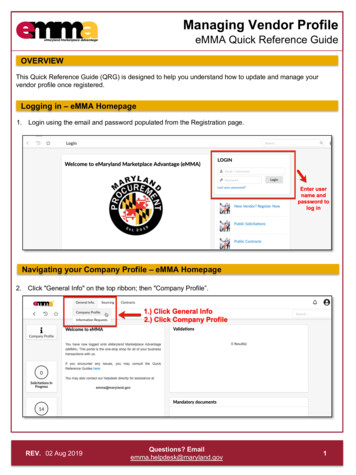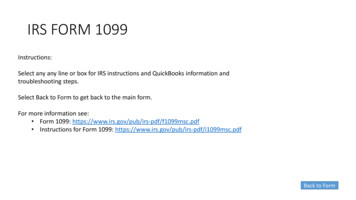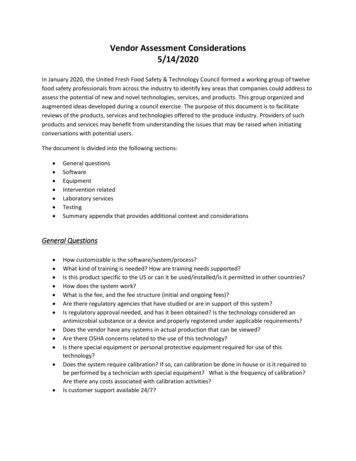
Transcription
Vendor Assessment Considerations5/14/2020In January 2020, the United Fresh Food Safety & Technology Council formed a working group of twelvefood safety professionals from across the industry to identify key areas that companies could address toassess the potential of new and novel technologies, services, and products. This group organized andaugmented ideas developed during a council exercise. The purpose of this document is to facilitatereviews of the products, services and technologies offered to the produce industry. Providers of suchproducts and services may benefit from understanding the issues that may be raised when initiatingconversations with potential users.The document is divided into the following sections: General questionsSoftwareEquipmentIntervention relatedLaboratory servicesTestingSummary appendix that provides additional context and considerationsGeneral Questions How customizable is the software/system/process?What kind of training is needed? How are training needs supported?Is this product specific to the US or can it be used/installed/is it permitted in other countries?How does the system work?What is the fee, and the fee structure (initial and ongoing fees)?Are there regulatory agencies that have studied or are in support of this system?Is regulatory approval needed, and has it been obtained? Is the technology considered anantimicrobial substance or a device and properly registered under applicable requirements?Does the vendor have any systems in actual production that can be viewed?Are there OSHA concerns related to the use of this technology?Is there special equipment or personal protective equipment required for use of thistechnology?Does the system require calibration? If so, can calibration be done in house or is it required tobe performed by a technician with special equipment? What is the frequency of calibration?Are there any costs associated with calibration activities?Is customer support available 24/7?
SoftwareRegarding software the things to consider involve how “off-the-shelf” the platform is. Key questionsrevolve around what the software really does and how well it works in your environment.Understanding your process workflow, who is capturing what data where, and how it is currently beingused are often misunderstood and this can be costly in terms of money and time. Some basicconsiderations: Software providers should be challenged to analyze your operation’s specific workflow and howthe software will capture it correctly, accounting for who is doing what now, and where andwhat the output of the data capture will look like.Will the use of this software require more people taking measurements or capturing data in adifferent way? Who is responsible for collecting and inputting data?If you are unable to conform current data capture to the way the software is currently designed,will it require programming changes? Is there a charge for this?If you need to add/delete information along the way will it require advanced programming andmean data loss? Are the data protected/not changeable?How often do software upgrades occur? Ask for actual data reports on this.What does a software upgrade look like? Do all users have to stop using the program/app?Does it require a system reset? What is the potential downtime for this? What are the typicalthings that go wrong? Is there a cost involved?If the vendor mentions a number of their current customers- ask them whether the customershave given their approval to use their name. How many of the customers mentioned are stillusing the software?What is the support program? Response time? Training? Turn-around time to resolve issueswith the software? Customer service support 24/7?For other data platforms for which you may want to combine data, how easy is it to get a datadump of the raw data?Will the vendor provide any examples of data linkage or data output between your system andothers?How are data stored (automatically, uploaded to the cloud)?If everything is pushed to the cloud what happens when access to the cloud is limited, e.g., deadspots or temporary outages?What specific features (e.g., traceability, documenting corrective actions) are included?How do the features correspond to audit requirements of different schemes/ regulations? Howeasy is it to demonstrate compliance?What languages are available? How can language barriers be overcome?For software that collects lab data, are you limited to using one lab or can data betransmitted/downloaded from other labs?What is the interoperability of this system with other software that you, customers, and/orvendors use?
What are the mechanisms for oversight/ review of data?What training is available for users during launching of software? What level of computercompetency is needed by users?Is there an ability to customize the software for specific applications?How many users are covered by the initial cost? Are there different levels of access andpermissions (e.g., admin, read-only etc.)?EquipmentIt is important to consider all aspects of equipment use, particularly preventive maintenance andsanitation, when considering new vendors. Most questions revolve around how to clean equipment anddetermining the level support given by vendors. Understanding your facility capabilities and layout isnecessary. Here are some basic questions: Are instructions/guidance available from the original equipment manufacturer regardingappropriate cleaning and sanitizing?How accessible are all areas to cleaning? How easy is it to fully break down the equipment?Is there training available on software, cleaning and operation of equipment?What are the validation studies on the process (wash equipment, modified atmosphere, etc.)?Does the vendor have certifications (OSHA, ASME, AWS, etc.)?If part of the equipment, what are the software capabilities?What is the pack/process/wash line capacity and how are they determined? For wash lines,what is required wash water vs product ratio in wash tanks?Intervention related (including antimicrobials)Very few interventions are truly a “kill step” and produce companies should be cautious of claims thatsound too good to be true. Efficacy in a laboratory setting rarely translates to the results achieved whenthe intervention is commercialized. What concentration/dose is needed? How was that established? What contact time/parameters are needed?Was a peer-reviewed validation study conducted?What are the details of a validation study (matrix, conditions, point/location/time of sampling,starting inoculum, type of organism, etc.)?Were physical and chemical factors considered as part of any validation and how would theyapply to your process?o Temperature: The activity of most disinfectants and sanitizers increases as thetemperature increases, but there are some exceptions. Too great of an increase intemperature can cause the disinfectant or sanitizer to degrade or even gas off.
o pH: An increase in pH improves the antimicrobial activity of some sanitizers anddisinfectants (glutaraldehyde and quaternary ammonium compounds), but decreasesthe activity of others (phenols, hypochlorites, and iodine).o Water hardness: This reduces the kill rate in certain sanitizers and disinfectants.What effect does organic or inorganic matter have on the efficacy?o Organic matter can interfere with the antimicrobial’s efficacy by interacting with theactive ingredient. It can also reduce the level of activity or protect the microorganismsfrom attack by acting as a physical barrier.How is the dose reliably administered, and how can that be monitored?What is the variation within the data (e.g., by season, location, product type, etc.)?What is the impact on product quality?Will there be any impact on equipment or other incompatibilities with your current system?How/where in the process is the intervention applied?How can this intervention fit within your current set up/process?Once the said system is in place, can/will the vendor help with a validated study in yourfacility/situation?Has the intervention been applied to a system similar to your process and validated? Are detailsand/or references available?Are there any waste disposal issues? Special treatments needed?Will the application require any changes to the label? Will organic or other status be affected?Is the antimicrobial technology a substance or device and properly registered under pesticideregistration requirements?o Substance: The use of the term substances and mixtures of substances in the definitionof pesticide provides the key to separating pesticides from devices. If the productcontains a substance that is intended to prevent, destroy, repel, or mitigate a pest thenthe product is a pesticide and, in general, will require EPA registration. Antimicrobialsubstances should have an EPA registration with the active ingredient for the product,organisms controlled, and concentrations required for sanitization and disinfection.o Device: If the product consists of an object or article that incorporates a substance ormixture of substances intended to prevent, destroy, repel, or mitigate any pest, theentire product is considered to be a pesticide and is subject to registration under FIFRAsection 3. Devices usually generate the antimicrobial onsite. Examples would beultraviolet light systems, ozone generators, and ultrasonic devices for which claims aremade to kill, inactivate, entrap, or suppress the growth of fungi, bacteria, or viruses invarious sites.Laboratory ServicesRegarding laboratory services, the most important questions revolve around the laboratory’s capabilitiesand certifications. Keep in mind your facility and employee needs and abilities when determining whichlab to use. Some basic questions are as follows: What is the sample turnaround time?How are results communicated? What level of detail accompanies the report?
Who has access to test results? What is the nature of notifications (and escalation, in the eventof a positive)?Has the lab been accredited? By whom, when and for what tests? Can a copy of the auditor’sreport be reviewed?What are the State and Federal certifications needed to perform the required test?Is there 24/7 customer support? Is there access to a dedicated customer services and supportteam?Does the customer have access to software to analyze data?What is the lab’s industry reputation? Can they provide referrals?TestingFor most methods, there is a delicate balance between time to result and accuracy. On the surface, theclaims usually focus on detection rates and on shorter turn-around times. When it comes to detectionunderstanding how many cells are needed for their method to detect is important. Enrichment time isalso often understated or even ignored. While there are PCR methods that give results in minutes, theyvirtually all need many hours of enrichment. Here are some questions to consider: Is the test considered “presumptive” or confirmatory? If presumptive, what would be needed toconfirm the result?How many analytes/ organisms are detected at the same time?On what product matrices was the method validated?Are there available third-party validations (AOAC, published studies, etc.)What is the evidence that the test kit functions and performs as advertised?How fresh was the product used in the validation? This is important because older,temperature-abused product pulled from a grocery outlet has very different microflora thansomething fresh at harvest.How many cells are needed for detection? What product volume/ mass is needed?How did the vendor get the number of cells to the instrument for detection (very important ifthey talk about very low numbers; were samples concentrated, what was the original samplevolume, how long was the enrichment, etc.)In laboratory trials where there is a claim about the ability to detect, ask how the sample(s)were set up? Did the vendor, for example, apply a known quantity directly to the instrument orsample collection point? How would this compare with collecting actual samples in a processingor production environment?Is enrichment required?How long and what are the conditions and preparation needed for the enrichment? Will itresuscitate injured/ damaged cells?What level of amplification is necessary for the detection technology to work?Can the test tell if the organism is alive or dead?
What are the false positive and false negative rates? How do they depend on other conditions(e.g., length of enrichment time).How specific is the test and what are the organisms for which there is cross-reactivity (e.g., atest for E. coli, vs STEC, vs O157:H7).Does the test yield a viable culture from which additional analyses can be done?If the fee is based on a price per test- what is the basis for that? Does this assume full capacity ofa system (e.g., “batching” of samples)? What if only one sample was run at a time?Does the vendor provide support with training of personnel?Is there customer support access 24/7?If the method it to be performed on-site, what kind of positive controls are needed and how canthey be safely managed? What kind of technical expertise, personal protective equipment, andlab facilities are needed?
Summary AppendixDeveloping an ecosystem of supplier networks across a range or areas is critical to ensure compliance withregulatory rules, speed to market, quality of product, and food safety. Establishing key parameters withappropriate guidelines will be critical to ensure that the suppliers are aligned with corporate governance in foodsafety and finance.Area: SoftwareGuideline for consideration:1. Required level of competency to run2. Training availability3. Customizability after start-up, and on-going after users get familiar4. Users covered by initial cost5. Customer service requirements, resolution time requirements6. Can it be expanded outside the US, available languages7. Compatibility with SAP or other in-house software system8. Cost structure; one time start-up fees, maintenance fees9. Compatible with regulatory agencies10. Beta testing programs availability, output and format requirements11. Cost effectiveness – less people, faster output12. Breadth of customizing allowed and cost13. Data loss contingency14. Cadence of upgrades, cost15. Ability to view on mobile devices, remote sensing capabilities16. Area coverage in the U.S.17. Compliance compatibility18. Features for traceability, documenting corrective actions19. If data collection from one lab, compatibility with other labsArea: EquipmentGuideline for consideration:1. Research and science support documentation2. Accessibility for cleaning/sanitation3. Training for operating, cleaning, and maintenance4. Validation studies5. Vendor certifications (OSHA, ASME, AWS, etc.)6. Software requirements7. Cost and expenses (operating)8. Pack/process/wash capacity, method of determination9. Ratio of wash water/product in wash tanks for wash linesArea: Interventions (including antimicrobials)Guideline for consideration:1. Liquid/solid or hardware, and registration under appropriate requirements:2. Describe the validation process. What are the standards used to ensure that ingredient or hardwareor both is achieving the desired result of prevention, reduction, or elimination of microbial hazards?3. What are other factors to consider that affect the efficacy of the ingredient, hardware, or both.4. Organic or inorganic matter effect on efficacy.
5.6.Confirm that substance will be effective on the surface applicable on which it will be used. Ensure noeffect on the function and appearance of the surfaces.Product matrices used for validationArea: Laboratory ServicesGuideline for consideration:1. Results timing and turnaround2. State and Federal certifications on required tests3. Customer service contracts and support4. Dashboard capabilities, support team5. Software for data analysis, and support6. References from customers, institutes, universitiesArea: Testing KitsGuideline for consideration:1. Validation studies completed or in-process, and applicability to product/process2. Third party validation partners3. Supporting data4. Vendor customer service and training (type)5. PPE requirements6. Calibration and accuracy requirements7. Protocol to get number of cells to instrument for detection8. Enrichment requirements; conditions, preparation9. Level of amplification necessary for detection technology to accurately measure10. Cost and price per test as it relates specifically to that product line11. Sample preparation requirement and alignment with validation studies12. Accuracy and precision; percent false negatives/positives13. Cross reactivity with different organisms14. Definition and type of indicators15. Microbe index16. Single/multiple target pathogens17. Arrays multiplex18. Operator skill level19. Time for results
Does the vendor have certifications (OSHA, ASME, AWS, etc.)? If part of the equipment, what are the software capabilities? What is the pack/process/wash line capacity and how are they determined? For wash lines, what is required wash water vs product ratio in wash tanks? Intervention related (including antimicrobials)
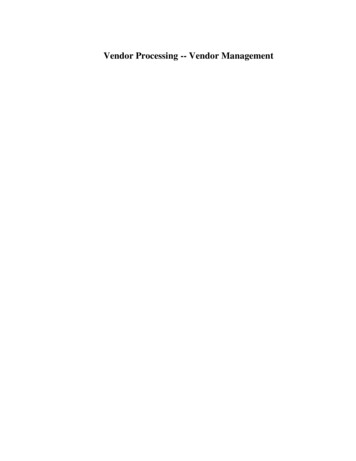
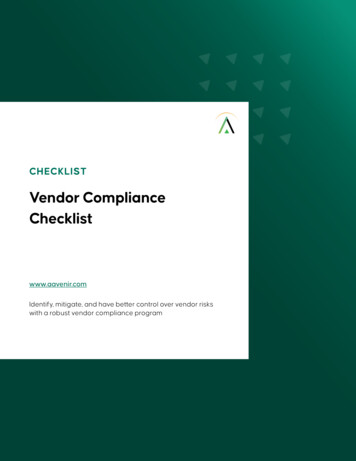
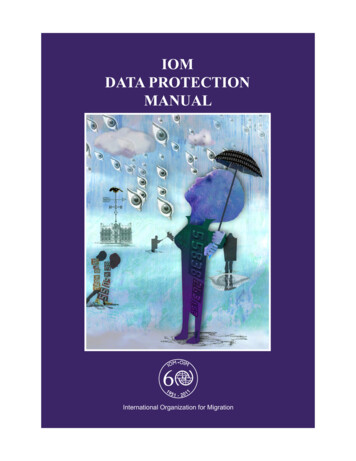
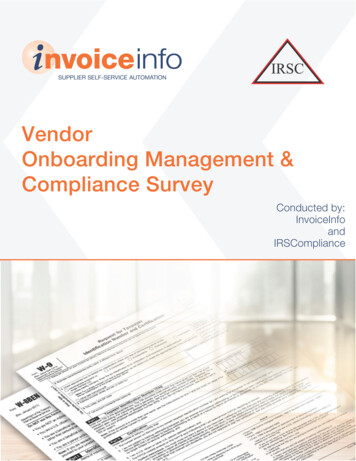
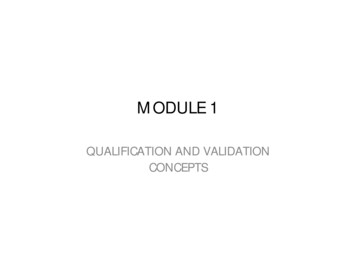
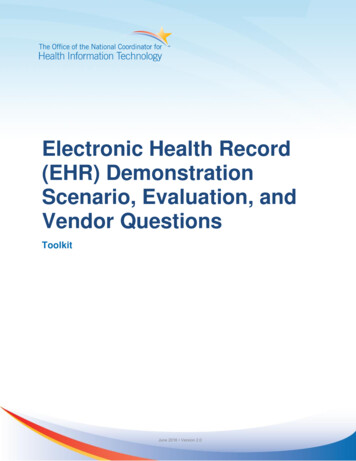
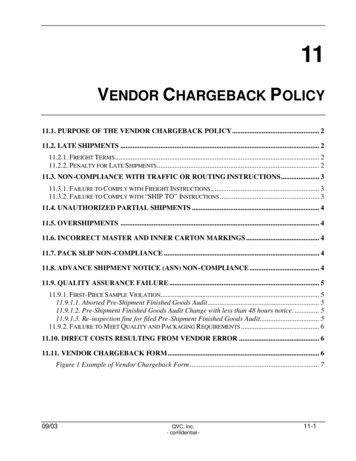
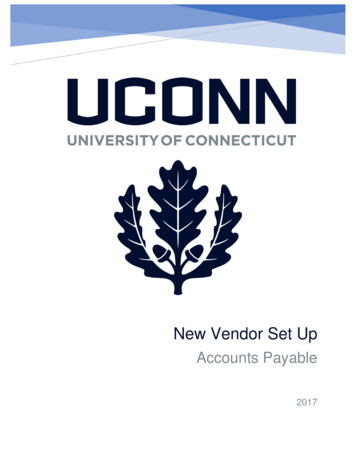
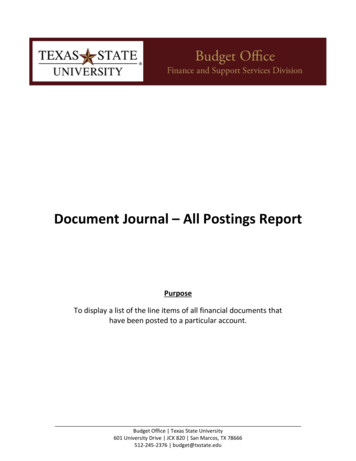
![Vendor Managed Inventory Master.pptx [Read-Only]](/img/27/vmi-learning-seminar.jpg)
